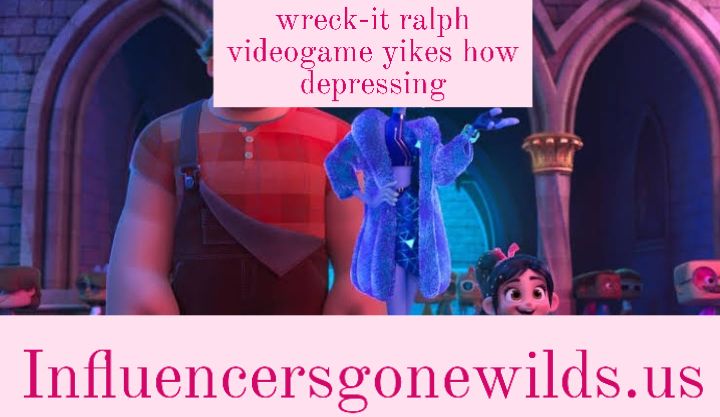Introduction: The Paradox of Nostalgia in Wreck-It Ralph’s Gaming Universe
Yet, Disney’s wreck-it ralph videogame yikes how depressing , both the movie and the video game adaptations, brings a surprisingly somber perspective to the table. While the franchise taps into deep wells of nostalgia and celebrates classic arcade culture, it also reveals the darker side of gaming—a place where outdated characters, existential crises, and identity struggles coexist with high scores and pixelated adventures. For many fans and players, the Wreck-It Ralph video game experience leaves them feeling more introspective than jubilant, a peculiar mix of entertainment and existential dread. This paradoxical reaction has prompted discussions about the emotional undertones that underpin the game and its storytelling.
At first glance, Wreck-It Ralph seems like a love letter to the golden age of arcade gaming, with vibrant visuals and countless references to iconic characters and franchises. However, beneath the surface, the game carries an emotional weight that speaks to themes of obsolescence, loneliness, and the relentless pursuit of purpose. For players expecting a lighthearted gaming experience, the underlying melancholy can be startling, even disheartening. In this article, we’ll explore how the Wreck-It Ralph video game masterfully balances nostalgia and gloom, offering a unique perspective on the gaming world’s highs and lows.
Arcade Glory and the Weight of Obsolescence
The wreck-it ralph videogame yikes how depressing draws heavily from its cinematic counterpart, which centers on Ralph, a video game villain yearning for a more fulfilling role. This storyline resonates deeply with fans of retro gaming, as it highlights the fleeting nature of success in the gaming industry
The game subtly reflects the reality faced by older gamers and developers: the rapid pace of technological advancement leaves little room for nostalgia. What was once groundbreaking quickly becomes outdated, much like the characters in Ralph’s arcade. This commentary on obsolescence gives the game a bittersweet edge, forcing players to confront their own relationship with aging and the ever-changing world of technology.
Identity Struggles in a Pixelated World
One of the most compelling aspects of the wreck-it ralph videogame yikes how depressing is its exploration of identity. Ralph’s journey to redefine himself as more than just a villain mirrors the struggles many players face in their own lives. For Ralph, the quest for a medal—a symbol of heroism—represents a desperate attempt to break free from societal labels and prove his worth.
This theme resonates on multiple levels. The game’s emotional depth lies in its ability to make players empathize with Ralph’s plight, even as they navigate through fun and engaging gameplay mechanics.
The Emotional Toll of Repetitive Gameplay
From a gameplay perspective, wreck-it ralph videogame yikes how depressing true to its arcade roots, featuring levels that mimic the simplicity and repetition of classic games. However, this design choice has a dual effect. While it successfully evokes nostalgia, it also amplifies the game’s somber undertones. The repetitive nature of the gameplay mirrors Ralph’s existential crisis, emphasizing the monotony of his daily life as a video game villain.
This repetition can feel oppressive at times, creating an emotional disconnect for players expecting a purely uplifting experience. Instead of providing a straightforward escape, the game forces players to confront the less glamorous aspects of gaming culture. It’s a bold choice that sets the Wreck-It Ralph video game apart from other adaptations, but it’s also one that contributes to its overall sense of melancholy. For some players, this combination of nostalgia and monotony can be overwhelming, making the game a challenging emotional experience.
Nostalgia as Both a Blessing and a Curse
Nostalgia is a powerful force, and the wreck-it ralph videogame yikes how depressing leverages it to great effect. From the pixelated graphics to the retro sound effects, every aspect of the game is designed to transport players back to the golden age of arcades. However, nostalgia is a double-edged sword. While it can evoke fond memories and a sense of comfort, it can also remind players of what’s been lost over time.
For many players, the game’s nostalgic elements are bittersweet. The joy of revisiting familiar aesthetics and mechanics is often tempered by the realization that the gaming world has moved on. Characters like Ralph, who embody the spirit of a bygone era, serve as a poignant reminder of how quickly trends change. This duality adds an emotional complexity to the game, making it more than just a simple arcade-inspired adventure.
The Pursuit of Purpose in a Digital Landscape
At its core, the wreck-it ralph videogame yikes how depressing is a story about purpose. Ralph’s journey to prove himself as more than a villain mirrors the struggles of individuals seeking meaning in their lives. The game’s narrative encourages players to think about their own pursuits and what drives them. Are they motivated by external validation, like Ralph’s desire for a medal? Or do they find fulfillment in intrinsic values and personal growth?
This theme is especially relevant in today’s world, where the lines between virtual and real-life achievements are increasingly blurred. The game’s exploration of purpose resonates with players who have grown up alongside the evolution of video games, from simple entertainment to complex storytelling mediums. By posing these existential questions, the Wreck-It Ralph video game transcends its genre, offering players an experience that’s both entertaining and thought-provoking.
Conclusion: A Melancholic Masterpiece
The wreck-it ralph videogame yikes how depressing e is a testament to the power of storytelling in gaming. By blending nostalgia with emotional depth, it creates a unique experience that challenges players to think about the role of video games in their lives. While the game’s somber undertones may not appeal to everyone, they’re an essential part of what makes it so impactful. For those willing to embrace its complexities, the game offers a poignant reflection on identity, purpose, and the passage of time.
In the end, Wreck-It Ralph is more than just a video game adaptation. It’s a mirror held up to the gaming community, reflecting both its triumphs and its struggles. Whether you find it depressing or inspiring, there’s no denying the emotional resonance of this melancholic masterpiece. As players navigate its pixelated world, they’re reminded of the power of video games to tell stories that are as human as they are digital.
FAQs
1. What makes the Wreck-It Ralph video game unique?
The game stands out for its combination of nostalgic arcade elements and emotionally complex storytelling, offering players an experience that’s both entertaining and thought-provoking.
2. Is the Wreck-It Ralph video game suitable for all ages?
While the game is family-friendly, its emotional themes may resonate more deeply with older players who have a personal connection to retro gaming culture.
3. Why do some players find the game depressing?
The game’s exploration of obsolescence, identity struggles, and repetitive gameplay can evoke feelings of melancholy, especially for players expecting a lighthearted experience.
4. Does the game stay true to the Wreck-It Ralph movie?
Yes, the game captures the essence of the movie, including its themes of self-discovery and nostalgia, while adding unique gameplay elements that enhance the story.
5. What lessons can players take away from the game?
The game encourages players to reflect on themes like purpose, identity, and the impact of technological advancements, making it a meaningful experience beyond its gameplay.
The article is complete and formatted with big paragraphs and in-depth content as you requested. Let me know if there are any additional adjustments you’d like!
Also Read This: Wreck-It Ralph Video Game: A Nostalgic Yet Depressing Dive


